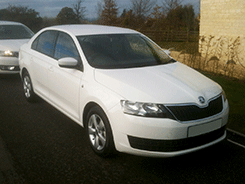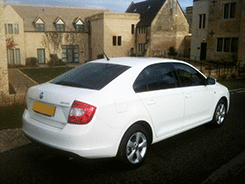First Driving Impressions – Skoda Rapid, UK Press Launch, Cheltenham
 The new Skoda Rapid we drove around Gloucestershire was the 1.2 litre TSI SE petrol model that produces 86ps. Other engines available are a 1.2 litre MPI 75ps petrol, 1.2 litre TSI 105ps petrol, 1.4 litre TSI 122ps petrol and a 1.6 litre TDI CR 105ps diesel. The 86ps engine is the one to have as it’s economical, quiet and has reasonably low CO2 emissions of 119g/km. Its official combined fuel consumption figure is 55.4 MPG, but strangely enough – and this has never happened before – we actually achieved an average which was more than the printed figure. We achieved nearly 60 MPG on the country roads and this dropped to just under 55 MPG when we upped the pace and took to the open roads.
The new Skoda Rapid we drove around Gloucestershire was the 1.2 litre TSI SE petrol model that produces 86ps. Other engines available are a 1.2 litre MPI 75ps petrol, 1.2 litre TSI 105ps petrol, 1.4 litre TSI 122ps petrol and a 1.6 litre TDI CR 105ps diesel. The 86ps engine is the one to have as it’s economical, quiet and has reasonably low CO2 emissions of 119g/km. Its official combined fuel consumption figure is 55.4 MPG, but strangely enough – and this has never happened before – we actually achieved an average which was more than the printed figure. We achieved nearly 60 MPG on the country roads and this dropped to just under 55 MPG when we upped the pace and took to the open roads.
This is the seventh model to join the Skoda line-up and it sits in between the Fabia and Octavia.
Skoda has gone back to their roots with the Rapid, by offering a car that’s good value, has plenty of room and provides good, basic comfort. Due to the car’s long wheelbase, it has more interior space and loads of luggage room, with the boot being enormous for a car that only measures 4.483mm long. When the seats are up it has 550 litre luggage capacity, and when they’re folded flat this increases to a massive 1,490 litres. The Rapid’s rear leg room is more than enough for even the tallest passenger, and the seats are firm yet comfortable. The interior package is more than adequate and offers a level of comfort and space more akin to a car with a much longer wheelbase and one that’s much more expensive; it really is superb.
This isn’t the first Rapid to be launched by Skoda: the first was in 1935 during the boom period for the brand.
The level of quality found in the Rapid’s interior is not up to the standard of many modern cars, but it’s more than acceptable. The plastics are a bit hard and all the lines are horizontal and lack any fancy or intricate detailing; it’s just good old-fashioned basic stuff in the cabin, but it all works well. The switchgear is good, with all the buttons, switches, stalks and handles being exactly where you need them. They look to be high in quality and they have a premium touch and sound to them.
 The exterior design has been kept basic, but the car has a new grille with the re-designed Skoda badge being on the bonnet and not part of the grille. There’s a bold swage line that runs from front to rear and the rear end looks more like a Saloon than a Hatchback, which works very well. The new Skoda badge has gone from being green and chrome to black and chrome, and what a difference the change makes; it’s so much nicer looking than the previous one.
The exterior design has been kept basic, but the car has a new grille with the re-designed Skoda badge being on the bonnet and not part of the grille. There’s a bold swage line that runs from front to rear and the rear end looks more like a Saloon than a Hatchback, which works very well. The new Skoda badge has gone from being green and chrome to black and chrome, and what a difference the change makes; it’s so much nicer looking than the previous one.
Out on the roads around Cheltenham the Rapid was not so rapid, but it was more than adequate with only the driver and passenger on board. With all that interior space and that huge boot, if the car was full to capacity I’m sure it would struggle a little going up some of the hills, particularly up in the north of England. However, it was quiet, the ride was good and it felt solid to drive.
This isn’t the first Rapid to be launched by Skoda: the first was in 1935 during the boom period for the brand. A second generation Rapid was launched in 1938, but with the outbreak of war, it didn’t exploit its full potential as the factory in Czechoslovakia was taken over by the German authorities, who swiftly used its state-of-the-art production facilities for military use. Skoda did however revive the famous Rapid name in the early 1980s and there are still around 48 of these models still in use today on UK roads. They’re becoming a future classic.
There are three trims available: S, SE and Elegance. Skoda expect to sell around 6,000 units in the UK, with prices starting from £12,900. The car to have is definitely the 1.2 litre 86ps SE at a cost of £14,650 on the road.
The latest generation Rapid offers good value for money, generous equipment levels, reasonable quality throughout and low BIK rates for company car drivers.





